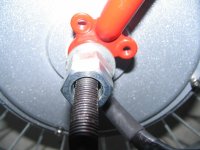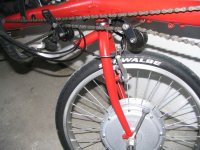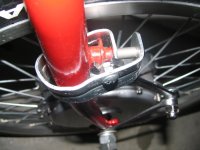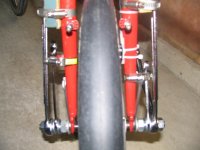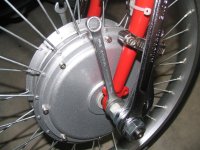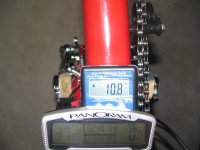mikereidis
1 kW
- Joined
- Jul 24, 2008
- Messages
- 343
I'm hoping to prevent a melted motor or blown controller. Any tips or comments on the limits I can put on an XLyte 404 20" front wheel with a 24-72v, 20a, XLyte 4110 fet pedal first ctrlr ?
I'm planning to upgrade the controller perhaps to recent Infineon and this 20 amp unit may become a backup and/or modified for higher current. What are 4110s doing in a mere 20a controller ? I chose pedal first because that makes a good backup that works without hall sensors.
This is my first e-bike build. My motor and controller should be here this week and I've started work on the battery pack. I've got 6 batteries of 20v and 6ah. So total in theory is 720wh. They are LiMn "Yardworks" batteries which are good for 30a continuous and switch off at 31a, or under 15v. I might go 4s, or 3s2p or buy more and do 4s2p (80v*60a)or 3s3p (60v*90a) .
.
My bike is an ATP Vision R40 recumbent with under seat steering. Me + bike + e-equipment might be 185 + 32 + 43 = 260 pounds. I hope to occasionally pull a good 2 kid trailer that might add up to 90 pounds for a total of 350 pounds.
Hills are an issue. I pedalled 50 km Sunday in heat and humidity with all 300+ pounds of us and 2 hills required getting out and pushing. I also live next to Gatineau Hills and some are quite difficult for this middle aged, low exercise smoker...
By checking hundreds of ebikes simulator graphs I came to the conclusion the best (least cost for needs) approach for me was an XLyte 404-405 in my 20" front wheel, paired with high voltage first, and high current second. Yes, current is like torque, which I need, but voltage helps to push it...
My main concern is, will I smoke the motor ? I guess that's a function of the heat generated within, which is the wasted power. So I ran some numbers, based on simulator results and that well know website equating watts with speed and incline. I've assumed 25 milliohms per battery and 10 milliohms controller resistance.
36v, 20a controller shows waste heat of 720 watts at 0 MPH. Is that right ? Just V*A at 0 ? At 5 MPH, good for 10% incline at full throttle I see 430 watts wasted. Is this sustainable on a 404 without killing the motor ? 430 watts ? Or perhaps just OK for 5-10 minutes ?
I'd prefer 72v at least at 20a though. 933 watts of waste at 5 MPH, but thats good for 17% incline, for average bike and rider I guess. Perhaps with my trailer I'd do much less like 12% maximum.
72v, 30a looks even nicer but wastes 1508 watts at 5 MPH full throttle. Of course you'll probably be quickly looking at 25 MPH where waste is only 555 watts, so this is only a brief peak.
I believe my pedal first controller should help relieve issues with 0 MPH stall currents.
Thanks !...
I'm planning to upgrade the controller perhaps to recent Infineon and this 20 amp unit may become a backup and/or modified for higher current. What are 4110s doing in a mere 20a controller ? I chose pedal first because that makes a good backup that works without hall sensors.
This is my first e-bike build. My motor and controller should be here this week and I've started work on the battery pack. I've got 6 batteries of 20v and 6ah. So total in theory is 720wh. They are LiMn "Yardworks" batteries which are good for 30a continuous and switch off at 31a, or under 15v. I might go 4s, or 3s2p or buy more and do 4s2p (80v*60a)or 3s3p (60v*90a)
My bike is an ATP Vision R40 recumbent with under seat steering. Me + bike + e-equipment might be 185 + 32 + 43 = 260 pounds. I hope to occasionally pull a good 2 kid trailer that might add up to 90 pounds for a total of 350 pounds.
Hills are an issue. I pedalled 50 km Sunday in heat and humidity with all 300+ pounds of us and 2 hills required getting out and pushing. I also live next to Gatineau Hills and some are quite difficult for this middle aged, low exercise smoker...
By checking hundreds of ebikes simulator graphs I came to the conclusion the best (least cost for needs) approach for me was an XLyte 404-405 in my 20" front wheel, paired with high voltage first, and high current second. Yes, current is like torque, which I need, but voltage helps to push it...
My main concern is, will I smoke the motor ? I guess that's a function of the heat generated within, which is the wasted power. So I ran some numbers, based on simulator results and that well know website equating watts with speed and incline. I've assumed 25 milliohms per battery and 10 milliohms controller resistance.
36v, 20a controller shows waste heat of 720 watts at 0 MPH. Is that right ? Just V*A at 0 ? At 5 MPH, good for 10% incline at full throttle I see 430 watts wasted. Is this sustainable on a 404 without killing the motor ? 430 watts ? Or perhaps just OK for 5-10 minutes ?
I'd prefer 72v at least at 20a though. 933 watts of waste at 5 MPH, but thats good for 17% incline, for average bike and rider I guess. Perhaps with my trailer I'd do much less like 12% maximum.
72v, 30a looks even nicer but wastes 1508 watts at 5 MPH full throttle. Of course you'll probably be quickly looking at 25 MPH where waste is only 555 watts, so this is only a brief peak.
I believe my pedal first controller should help relieve issues with 0 MPH stall currents.
Thanks !...




